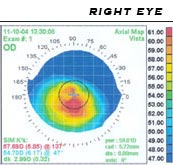
English: Scheme of keratoconus compared to normal cornea Polski: Schemat porównujący prawidłową rogówkę do stożka rogówki Hrvatski: Skica keratokonusa u usporedbi s normalnom rožnicom (Photo credit: Wikipedia)
Keratoconus is a condition in which the cornea (the lens of the eye) begins to have structural fluctuations, causing it to thin and change to a more conical shape than its normal gradual curve.
The cornea has three major parts, the outer layer, epithelium, the central structural portion, the stroma, which provides the cornea’s shape, and the endothelium, which prevents swelling of the cornea. Keratoconus is a disease of the corneal stroma. The stroma comprises over 85% of the cornea, and is made up of collagen, similar to the material on the tip of your nose. With keratoconus, the cornea loses its usual round shape, and develops in to a cone-like shape.
In the initial stages of keratoconus, vision will fluctuate, causing astigmatism. As the condition progresses, the cornea becomes too irregular for the use of glasses, and special contact lenses, called Scleral Lenses are needed. The new generation of Scleral lenses are now very comfortable in the eye and most importantly correct the distortion caused by keratoconus.
Keratoconus is a progressive corneal condition, and regularly starts in the teenage years. Now with Scleral lenses, people with keratoconus can have great comfortable vision. It’s always in a person’s best interest to avoid corneal transplants and other surgical procedures.
Dr. Irwin Azman specialists in the fitting of Scleral contact lenses for keratoconus, Lasik failures and complications, Pellucid Marginal Degeneration, Stevens-Johnson Syndrome, and other corneal irregularities.
